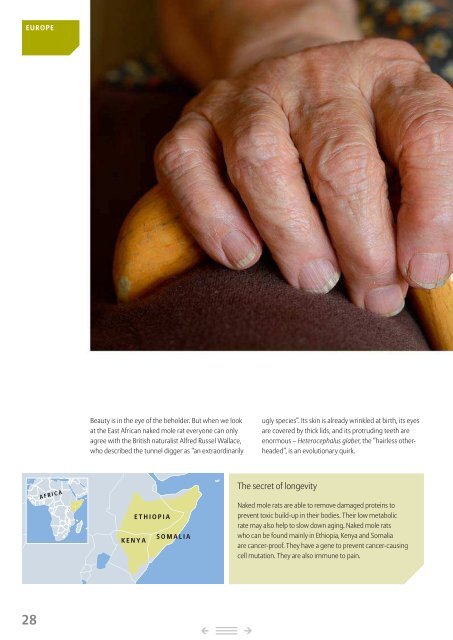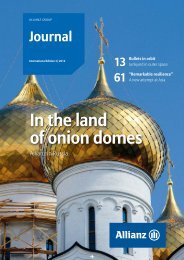Journal - Allianz
Journal - Allianz
Journal - Allianz
Create successful ePaper yourself
Turn your PDF publications into a flip-book with our unique Google optimized e-Paper software.
EUROPE<br />
Shutterstock<br />
<strong>Allianz</strong> Group <strong>Journal</strong> 2/2013<br />
in relatively good health. Early this year Buffenstein<br />
received the Longevity Research Award worth 15,000<br />
euros from <strong>Allianz</strong> France and the French Healthcare<br />
Association Les Associations de Prévoyance Santé for her<br />
pioneering work.<br />
AFRICA<br />
Beauty is in the eye of the beholder. But when we look<br />
at the East African naked mole rat everyone can only<br />
agree with the British naturalist Alfred Russel Wallace,<br />
who described the tunnel digger as “an extraordinarily<br />
KENYA<br />
ETHIOPIA<br />
SOMALIA<br />
ugly species”. Its skin is already wrinkled at birth, its eyes<br />
are covered by thick lids, and its protruding teeth are<br />
enormous – Heterocephalus glaber, the “hairless otherheaded”,<br />
is an evolutionary quirk.<br />
The secret of longevity<br />
Naked mole rats are able to remove damaged proteins to<br />
prevent toxic build-up in their bodies. Their low metabolic<br />
rate may also help to slow down aging. Naked mole rats<br />
who can be found mainly in Ethiopia, Kenya and Somalia<br />
are cancer-proof. They have a gene to prevent cancer-causing<br />
cell mutation. They are also immune to pain.<br />
A quirk admittedly that has fascinated scientists ever<br />
since the animal was first described by the German<br />
biologist Eduard Rüppell in 1842. This is partly due to<br />
the fact that the naked mole rat lives in colonies that are<br />
organized in a similar way to an ant or bee colony – a<br />
unique social structure among mammals. The mousesize<br />
animal also contradicts conventional wisdom that<br />
small species have a shorter lifespan than larger ones:<br />
Unlike mice, which usually survive for no more than<br />
three years, naked mole rats can live for 30 years, biblical<br />
by comparison, and remain healthy to boot.<br />
The naked mole rat is thus a perfect research object<br />
for scientists like Rochelle Buffenstein of the Barshop<br />
Institute for Longevity and Aging Studies at the University<br />
of Texas. The American is researching the cellular<br />
mechanisms that permit the naked mole rat to age<br />
Some might find it a bit disconcerting that the pinnacle<br />
of creation is seeking analogies in a creature that fate has<br />
so blatantly dealt a bad hand. But maybe naked mole rats<br />
actually do carry the secret of longevity in their wrinkled<br />
little bodies. There is at least some evidence that their<br />
life expectancy is increased by sexual abstinence, calorie<br />
restriction and constant physical activity. Still, with such a<br />
life in prospect, we might ask “what for”?<br />
Only the queen and one to three males provide offspring<br />
in the colony. The others dig fresh tunnels the day long in<br />
search of food, clean the burrow and look after the pups.<br />
If the queen dies, the females next in line to the throne<br />
often engage in violent fighting, shredding each other’s<br />
wrinkly skins to the bone, sometimes with fatal consequences.<br />
Males, on the other hand, don’t exactly fall over<br />
themselves for a place at court. It is still unclear why<br />
those who then come forward to mate with the queen<br />
suddenly age rapidly – but we have our suspicions.<br />
It’s also a mystery why, despite a high rate of incest, the<br />
sausage-like Methuselahs rarely suffer from hereditary<br />
diseases or why they don’t succumb to cancer or osteoporosis<br />
in old age. Meanwhile, humans are living longer<br />
even without solving the naked mole rat code. According<br />
to the UN, there are already over 340,000 men and<br />
women in the world who are one hundred years old or<br />
older. In 2050 there will probably be ten times that many.<br />
Statistically speaking, well-educated women have the<br />
greatest chance of reaching 100. This adds a whole new<br />
meaning to the phrase “learning for life”.<br />
HTTP://BARSHOPINSTITUTE.UTHSCSA.EDU<br />
340,000<br />
3,400,000<br />
2013 2050<br />
CENTENARIANS<br />
WORLDWIDE<br />
28<br />
<br />
<br />
<br />
<br />
29










